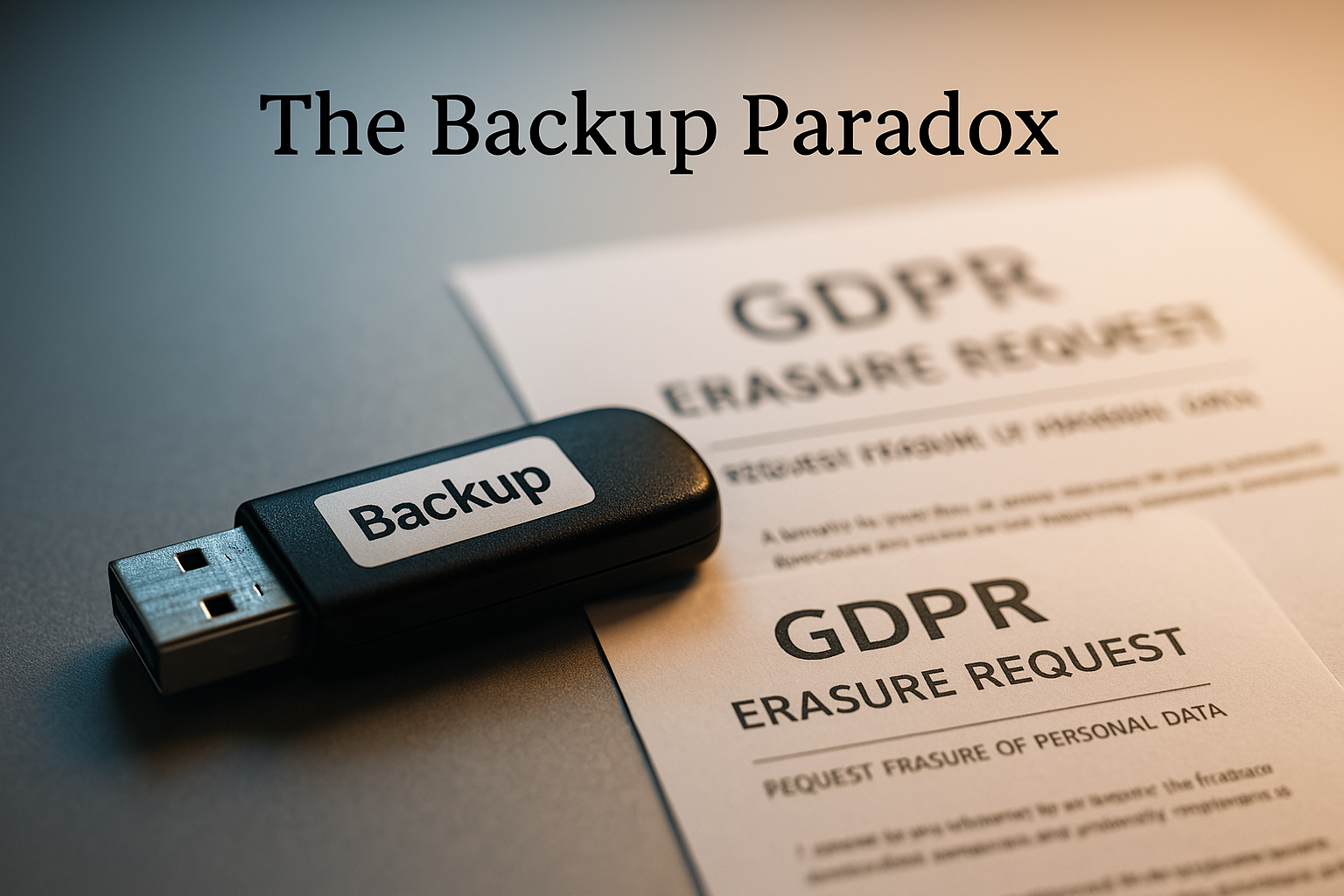The Backup Paradox and GDPR
Among the many challenges the GDPR presents, one of the most persistent and complex is the Backup Paradox. It sits at the intersection of legal obligation and technical architecture, revealing a conflict between the right to erasure and the operational demands of data resilience.
While GDPR introduces several paradoxes—such as detection complexity, vendor control, and data minimization—this article focuses on one that affects nearly every organization: the Backup Paradox.
What Is the Backup Paradox?
The GDPR’s Article 17 grants individuals the right to request the deletion of their personal data. In theory, this empowers data subjects and compels organizations to act promptly. However, in practice, this right collides head-on with the reality of data backup systems.
Backups are designed to be immutable, complete, and restorable. These characteristics are essential for disaster recovery and operational continuity. But they also mean that deleting an individual record without altering the integrity of the entire backup is often technically impossible.
This leads to a dilemma: organizations must honor deletion requests, yet their infrastructure may not allow for selective erasure without jeopardizing backup functionality. In essence, fulfilling GDPR obligations could undermine the very systems built to ensure business stability.
Why the Backup Paradox Matters for GDPR Compliance
Despite the technical hurdles, legal accountability under GDPR remains clear. Article 5(2) emphasizes the accountability principle—controllers must demonstrate compliance with all data protection rules, even when facing practical difficulties.
This creates a friction point between legal and operational expectations. On one hand, GDPR requires data minimization and timely erasure. On the other, IT systems are often architected with redundancy and resilience as top priorities.
When these priorities misalign, organizations risk non-compliance, which could lead to regulatory scrutiny, fines, or reputational harm. The paradox also highlights a broader issue: many IT systems were not designed with GDPR in mind, exposing a critical gap between policy and infrastructure.
Technical and Legal Tensions Behind the Paradox
The mechanics of backup systems add another layer of complexity. Formats such as magnetic tape, WORM (write-once, read-many) drives, and compressed full-disk images are notoriously resistant to granular edits. Attempting to modify them to delete specific records could corrupt the backup entirely.
Additionally, backup restoration procedures can inadvertently reintroduce deleted data into active systems, undermining compliance efforts. For example, if a previously erased customer record is restored as part of a system-wide rollback, the organization could unknowingly violate Article 17.
This catch-22 places organizations in a difficult position: delete and risk operational failure, or retain and risk legal penalties.
Strategies for Navigating the Backup Paradox
There is no single solution, but several practical strategies can help organizations strike a balance between GDPR compliance and business continuity.
Policy-Based Logical Deletion
Rather than physically deleting records from backups, organizations can implement logical deletion—flagging data as deleted in active systems while retaining it in backups until they expire naturally. This approach preserves backup integrity while signaling that the data should not be restored or processed.
Encryption and Key Destruction
Encrypting backups and managing encryption keys offers another solution. If personal data is encrypted at rest and the key is securely destroyed, the data becomes inaccessible—achieving effective erasure without touching the backup itself.
Retention Scheduling
Establishing clear retention timelines for backups can help align technical practices with legal requirements. By limiting how long backups are stored, organizations reduce their exposure to long-term GDPR conflicts. Backup lifecycle policies should reflect the minimum period necessary for operational security.
Transparent Communication
Organizations should also update privacy notices and policies to explain how backups are handled. This transparency sets realistic expectations for data subjects while demonstrating good faith compliance to regulators.
What Regulators Expect from Organizations
While regulators recognize the technical challenges of managing shadow data and backups, they do not offer exemptions from GDPR obligations. Data protection authorities (DPAs) expect organizations to document their data handling practices, conduct risk assessments, and make demonstrable efforts toward compliance.
This includes:
- Maintaining clear records of backup systems and their limitations
- Implementing and documenting logical or technical deletion processes
- Updating contracts with processors to reflect backup handling protocols
- Conducting Data Protection Impact Assessments (DPIAs) where appropriate
While enforcement actions specifically tied to backups are rare, DPAs have issued warnings about unmanaged legacy systems and insufficient data governance—both of which relate to the Backup Paradox.
Designing Future-Proof Systems with Privacy by Design
To move beyond reactive solutions, organizations should embrace Privacy by Design principles. This means embedding data minimization and deletion capabilities into system architecture from the outset.
Next-generation backup systems should support selective erasure or use intelligent encryption frameworks to enable secure, compliant storage. Privacy professionals should collaborate with IT architects early in system design to align technical resilience with legal accountability.
By doing so, businesses can reduce their dependence on workaround strategies and create systems that are resilient and privacy-compliant by default.
From Paradox to Progress
The Backup Paradox isn’t a loophole or an excuse—it’s a reminder of the evolving complexity of data governance in the GDPR era. Privacy professionals must navigate a landscape where technical limitations clash with regulatory mandates.
Success lies in embracing transparency, applying innovative solutions like encryption and retention scheduling, and designing systems with privacy as a core component—not an afterthought. GDPR compliance isn't about perfection; it’s about making intentional, documented efforts to align operations with the law.



